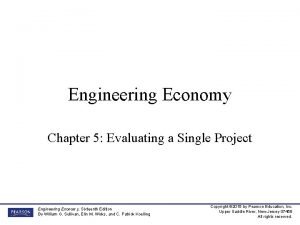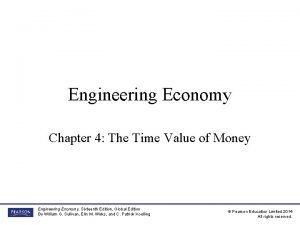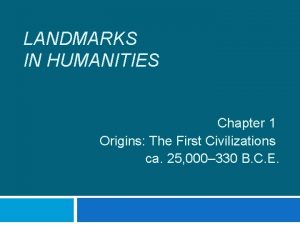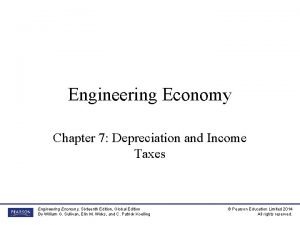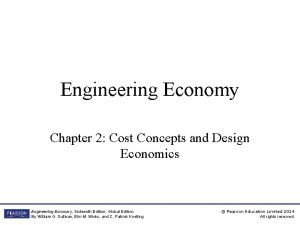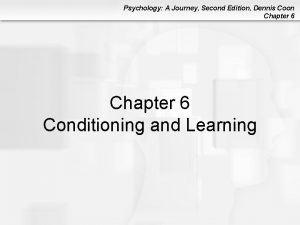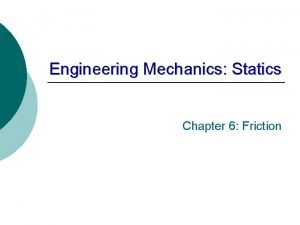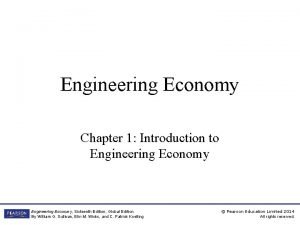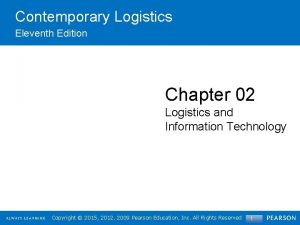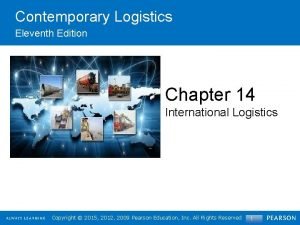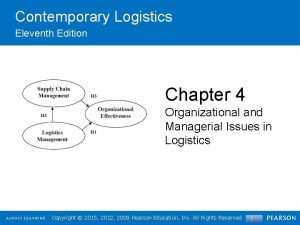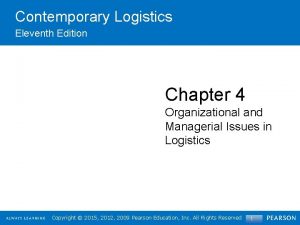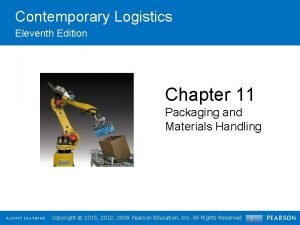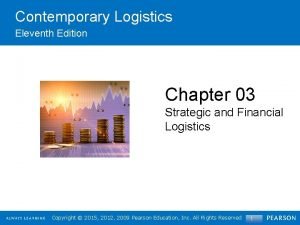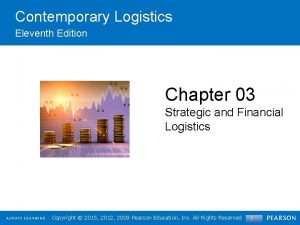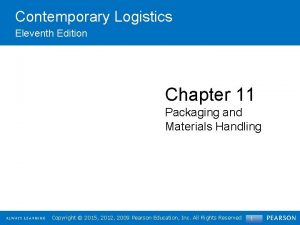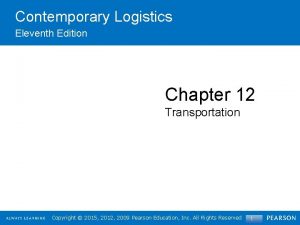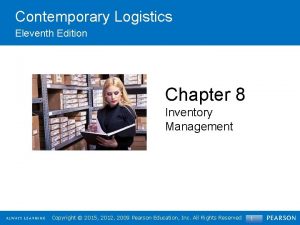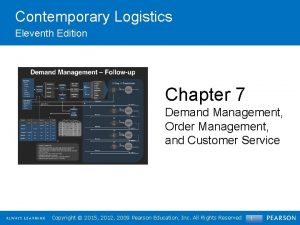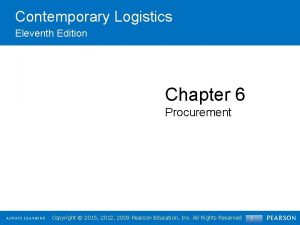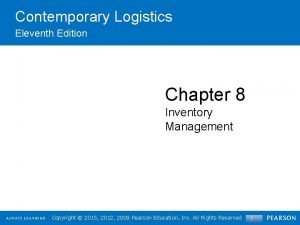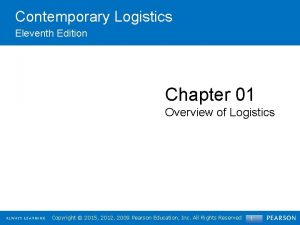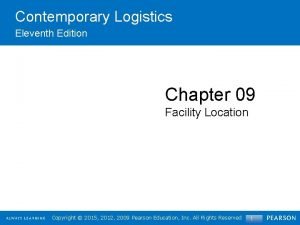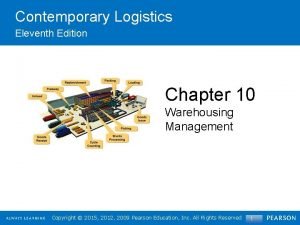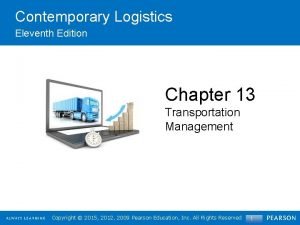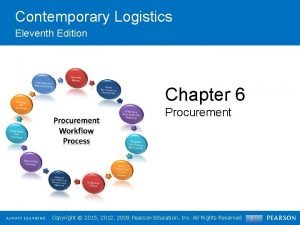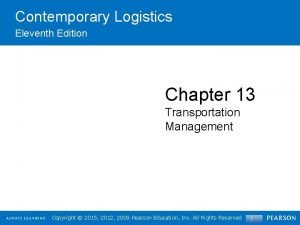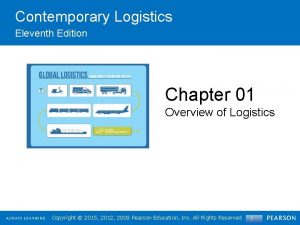Contemporary Logistics Eleventh Edition Chapter 02 Logistics and
















































- Slides: 48

Contemporary Logistics Eleventh Edition Chapter 02 Logistics and Information Technology Copyright©© 2015, 2012, 2009 Pearson. Education, Inc. All. Rights. Reserved Copyright 1

Logistics and Information Technology Key Terms (1 of 2) • Application specific software • Big Data • Cloud computing • Data mining • Data warehouse • Electronic data interchange (EDI) • Electronic procurement (e-procurement) • Enterprise resource planning (ERP) system • Global positioning systems (GPS) • Information Copyright © 2015, 2012, 2009 Pearson Education, Inc. All Rights Reserved 2

Logistics and Information Technology Key Terms (2 of 2) • Logistics information system (LIS) • Simulation • Logistics optimization models • Transportation Management System (TMS) • On-demand software (software-as-a-service) • Warehouse Management System (WMS) • Radio-frequency identification (RFID) • Wireless communication • Reverse auction Copyright © 2015, 2012, 2009 Pearson Education, Inc. All Rights Reserved 3

Learning Objectives • To appreciate the importance of effective and efficient utilization of information for logistics management • To learn about general types of information systems and their logistical applications • To look at the Internet’s influence on logistics • To learn about select information technology challenges Copyright © 2015, 2012, 2009 Pearson Education, Inc. All Rights Reserved 4

5 Overview of Class • Chapter 2 • In-Class Activities (seen on pwpt) – Participation Copyright © 2015, 2012, 2009 Pearson Education, Inc. All Rights Reserved 5

News and Books • Trends in Logistics Tech • Good Read: "E-logistics"--new logistic management practices for the internet--can result in faster shipping times, better customer service, and streamlined information within and between supply chain management companies. Edited by Yingli Wang and Steve Pettit, this collection features international experts from both academia and industry who examine how competitiveness and productivity in transportation, logistics, and supply chain management can be improved using e-logistics systems and technologies. Copyright © 2015, 2012, 2009 Pearson© 2015 Cengage Learning Education, Inc. All Rights Reserved 6

Benefits of Effective and Efficient Use of Information • Greater knowledge and visibility across the supply chain • Greater awareness of customer demand via point-ofsale data • Better coordination of manufacturing, marketing, and distribution • Streamlined order processing and reduced lead-times Copyright © 2015, 2012, 2009 Pearson Education, Inc. All Rights Reserved 7

Figure 2. 1: General Types of Information Management Systems System type Logistics examples Office automation system: provides effective ways to process personal and organizational business data, to perform calculations, and to create documents Spreadsheet applications to calculate optimal order quantities, facility location, transport cost minimization, among others Communication system: helps people work together by interacting and sharing information in many different forms Virtual meetings via computer technology Voice-based order picking Transaction processing system (TPS): collects and stores Electronic data interchange information about transactions; controls some aspects of Automatic identification technologies such as transactions bar codes Point-of-sale systems Management information system (MIS) and executive information system (EIS): converts TPS data into information for monitoring performance and managing an organization; provides executives information in a readily accessible format Logistics information system Decision support system (DSS): helps people make Simulation decisions by providing information, models, or analysis tools Application-specific software such as warehouse management systems Data mining Enterprise system: creates and maintains consistent data processing methods and an integrated database across multiple business functions Logistics modules of enterprise resource planning systems Copyright © 2015, 2012, 2009 Pearson Education, Inc. All Rights Reserved 8

General Types of Information Management Systems (1 of 22) Office automation systems: • Provide effective ways to • Process personal and organizational business data • Perform calculations • Create documents Copyright © 2015, 2012, 2009 Pearson Education, Inc. All Rights Reserved 9

1– 10 Class Participation • What kinds of devices do you use in your office that are automation? Copyright © 2015, 2012, 2009 Pearson Education, Inc. All Rights Reserved 10

General Types of Information Management Systems (2 of 22) • Include general software packages • Word processing • Spreadsheet (most relevant for logisticians) • Presentation • Database management applications • Spreadsheet (most relevant for logisticians) • Able to solve for basic logistic optimization models through add-in packages such as “What’s Best” Copyright © 2015, 2012, 2009 Pearson Education, Inc. All Rights Reserved 11

General Types of Information Management Systems (3 of 22) Communication system • Help stakeholders work together by interacting and sharing information in many different forms • Examples of telecommunication technologies • Fax machines • Personal computers • Electronic mail • Cellular phones • Tablets • Smart phones Copyright © 2015, 2012, 2009 Pearson Education, Inc. All Rights Reserved 12

General Types of Information Management Systems (4 of 22) • Examples of logistics information technology • Electronic data interchange (EDI) • Viewed as the measuring stick in the 1990’s • Wireless communication • Emerged as the measuring stick during the first decade of the twenty-first century • Device examples include • Global positioning systems (GPS) • GPS Logistics • Tablets (such as Apple’s i. Pad) Copyright © 2015, 2012, 2009 Pearson Education, Inc. All Rights Reserved 13

General Types of Information Management Systems (5 of 22) Transaction Processing System (TPS) • Collects and stores information about transactions • Efficient processing of transactions with a choice of • Real-time processing or • Batch processing • Examples include • Electronic data interchange (EDI) • Automatic identification technologies • Essential component in point-of-sale (POS) systems Copyright © 2015, 2012, 2009 Pearson Education, Inc. All Rights Reserved 14

General Types of Information Management Systems (6 of 22) Transaction Processing System (TPS) (continued) Benefits of EDI Reduced document preparation and processing time Reduced inventory carrying costs Reduced personnel costs Reduced Information float Reduced shipping errors Reduced lead times Reduced order cycle times Reduced ordering costs Increased cash flow Increased billing accuracy Increased productivity Increase customer satisfaction Copyright © 2015, 2012, 2009 Pearson Education, Inc. All Rights Reserved 15

General Types of Information Management Systems (7 of 22) Transaction Processing System (TPS) (continued) Drawbacks of EDI Lack of awareness of the benefits of EDI High setup costs Lack of standard formats Incompatibility of computer hardware and software Reduced shipping errors Reduced lead times Reduced order cycle times Reduced ordering costs Copyright © 2015, 2012, 2009 Pearson Education, Inc. All Rights Reserved 16

General Types of Information Management Systems (8 of 22) Transaction Processing System (TPS) • Examples of automatic identification technologies • Optical character recognition • Machine vision • Voice-data entry • Magnetic strips • Bar code scanners • Radio-frequency identification (RFID) Copyright © 2015, 2012, 2009 Pearson Education, Inc. All Rights Reserved 17

General Types of Information Management Systems (9 of 22) Transaction Processing System (TPS) • RFID Consists of: 1. A scanning antenna 2. An RFID tag (chip) that conveys relevant data 1. RFID video 3. A receiver that interprets the data • Compared to bar codes, RFID 1. Does not require clear line of sight between an object and RFID hardware 2. Can store much larger quantities of data 3. Can offer both read and write capabilities Copyright © 2015, 2012, 2009 Pearson Education, Inc. All Rights Reserved 18

1– 19 Class Participation • What is your thoughts on the RFID on your phone usage? • Amazon Copyright © 2015, 2012, 2009 Pearson Education, Inc. All Rights Reserved 19

General Types of Information Management Systems (10 of 22) Management Information System (MIS) and Executive Information System (EIS) • Convert TPS data into information for monitoring performance and managing an organization • Objective is to provide managers and executives the information they really need • MIS Copyright © 2015, 2012, 2009 Pearson Education, Inc. All Rights Reserved 20

General Types of Information Management Systems (11 of 22) Management Information System (MIS) and Executive Information System (EIS) • A logistics information system (LIS) can be defined as “the people, equipment, and procedures to gather, sort, analyze, evaluate, and distribute needed, timely, and accurate information to logistics decision makers. ” 1 Copyright © 2015, 2012, 2009 Pearson Education, Inc. All Rights Reserved 21

General Types of Information Management Systems (12 of 22) Management Information System (MIS) and Executive Information System (EIS) Figure 2. 2: Structure and Function of a Logistics Information System Source: Adapted from Michael Etzel, Bruce Walker, and William Stanton, Marketing, 14 th ed. (New York: Mc. Graw-Hill Irwin, 2007), p. 172. Copyright © 2015, 2012, 2009 Pearson Education, Inc. All Rights Reserved 22

General Types of Information Management Systems (13 of 22) Decision Support Systems (DSS) • Help managers make decisions by providing information, models, or analysis tools • Examples of specific uses include • • Vehicle routing issues Inventory control decisions Developing automatic order picking systems Optimization models for buyer-seller negotiations Copyright © 2015, 2012, 2009 Pearson Education, Inc. All Rights Reserved 23

General Types of Information Management Systems (14 of 22) Decision Support Systems (DSS) • Several prominent DSS techniques include: • Simulation • Technique that models a real-world system, typically using mathematical equations to represent the relationships among the system’s components Copyright © 2015, 2012, 2009 Pearson Education, Inc. All Rights Reserved 24

General Types of Information Management Systems (15 of 22) Decision Support Systems (DSS) • Several prominent DSS techniques include: • Application specific software • Technique developed to help managers deal with specific logistics processes or activities • Popular option includes on-demand software (also referred to as software-as-a-service or cloud computing) Copyright © 2015, 2012, 2009 Pearson Education, Inc. All Rights Reserved 25

General Types of Information Management Systems (16 of 22) Decision Support Systems (DSS) • Examples of logistics-related application-specific software • Transportation management systems (TMS) • Software package that automates the process of building orders, tending loads, tacking shipments, audits, and payments 1 • TMS 1 Amy Zucherman, “Transportation Management Systems Give Shippers Power to Make Smarter Trucking Choices, ” World Trade, January 2008, 34 -38. Copyright © 2015, 2012, 2009 Pearson Education, Inc. All Rights Reserved 26

General Types of Information Management Systems (17 of 22) Decision Support Systems (DSS) • Examples of logistics-related application-specific software • Warehouse management systems (WMS) • Software package that provides oversight of the storage and flow of materials within a company’s operations 2 • WMS 2 Dave Piasecki, “Warehouse Management Systems, ” www. inventoryops. com. Copyright © 2015, 2012, 2009 Pearson Education, Inc. All Rights Reserved 27

General Types of Information Management Systems (18 of 22) Table 2. 1: Transportation Management Systems Task Capabilities Decision Support Systems (DSS) Task Capability Asset tracking Carrier selection Claims management Driver management Freight payment Load planning Load tendering Order or shipment visibility Package delivery verification Package pickup tracking Pickup scheduling Rating Real-time route reporting Route optimization Shipment consolidation Empty Source: “Transportation Management Systems Solution Selector, ” Logistics Today, September 2004, 76– 80. Copyright © 2015, 2012, 2009 Pearson Education, Inc. All Rights Reserved 28

General Types of Information Management Systems (19 of 22) Decision Support Systems (DSS) • Data mining – a DSS technique • Is the application of mathematical tools to large bodies of data in order to extract correlations and rules 1 • Dependent on data warehouses • Central repository for all relevant data collected by an organization Copyright © 2015, 2012, 2009 Pearson Education, Inc. All Rights Reserved 29 1 Sam Joseph and Daniel Scuka, “AI”, Japan Inc. , November 2001, 20 -28.

General Types of Information Management Systems (20 of 22) Enterprise Systems • Create and maintain consistent data processing methods and an integrated database across multiple business functions 1 1 Alter, Information Systems, Chapter 5. Copyright © 2015, 2012, 2009 Pearson Education, Inc. All Rights Reserved 30

General Types of Information Management Systems (21 of 22) Enterprise Systems • Enterprise Systems example: • Enterprise resource planning (ERP) • “lets a company automate and integrate the majority of its business processes, share common data and practices across the enterprise, and produce and access information in a real-time environment” 1 1 Joel D. Wisner, G. Keong Leong, and Keah-Choon Tan, Principles Chain Management: A Balanced Cengage Learning, 2008), p. 507. of Supply Approach, 2 nd ed. (Mason, OH: South-Western Copyright © 2015, 2012, 2009 Pearson Education, Inc. All Rights Reserved 31

General Types of Information Management Systems (22 of 22) Enterprise Systems • Shortcomings of Enterprise resource planning (ERP) • Costs of installation • Time-consuming installation process • Initially lacked strong application-specific logistical capabilities such as TMS or WMS Copyright © 2015, 2012, 2009 Pearson Education, Inc. All Rights Reserved 32

The Internet’s Influence on Logistics (1 of 13) • Approximately 35% of the world’s population uses the internet – up from 5% at the beginning of the 21 st century • 3 Specific Influences on Logistics Include: 1. Online retailing 2. Cloud computing 3. Electronic procurement Copyright © 2015, 2012, 2009 Pearson Education, Inc. All Rights Reserved 33

The Internet’s Influence on Logistics (2 of 13) Similarities between online retailing and in-store retailing Logistical Functions and Activities Equipment and Materials Transportation Bar coding Warehousing WMSs Materials handling Empty Order management Empty Copyright © 2015, 2012, 2009 Pearson Education, Inc. All Rights Reserved 34

The Internet’s Influence on Logistics (3 of 13) Differences between online retailing and in-store retailing Online Retailing In-store Retailing More, smaller orders Fewer, larger orders Order management systems must handle large volumes of orders Order management system is set up to handle orders from resellers, not consumers Information management systems capable of correctly transmitting each order so it can be filled in a timely fashion Full-case picking Smaller orders dictate open-case picking Warehouse set up to handle large volume orders Copyright © 2015, 2012, 2009 Pearson Education, Inc. All Rights Reserved 35

The Internet’s Influence on Logistics (4 of 13) Differences between online retailing and in-store retailing Online Retailing In-store Retailing Products slotted to facilitate picking smaller orders Variety of materials handling equipment used Totes and push carts used Packaging generally cartons that hold large volume orders Packaging is small cartons, envelopes, Empty bags suited to holding small quantities Copyright © 2015, 2012, 2009 Pearson Education, Inc. All Rights Reserved 36

The Internet’s Influence on Logistics (5 of 13) Differences between online retailing and in-store retailing Online Retailing Transportation companies used with extensive delivery networks; experience in parcel shipments In-store Retailing Transportation methods and companies vary by request of buyer Outbound shipments usually picked up Outbound shipments may be picked by vans up by tractor trailers or railcars Return rates much higher and from ultimate consumers Return rates lower and from resellers Copyright © 2015, 2012, 2009 Pearson Education, Inc. All Rights Reserved 37

The Internet’s Influence on Logistics (6 of 13) • Cloud Computing • Worldwide public cloud services market – where software, services, or information are shared via the Internet without the users having control over the technology infrastructure – grew almost 20% between 2011 and 20121 1 Bridget Mc. Crea, “Cloud Breakthrough, ” Logistics Management 51, no. 11 (2012): 36 -40. Copyright © 2015, 2012, 2009 Pearson Education, Inc. All Rights Reserved 38

The Internet’s Influence on Logistics (7 of 13) • Cloud Computing • Advantages of Cloud Computing • Pay-per-use allows firms to avoid high capital investment which speeds up ROI for the software • Since it involves operational as opposed to capital expenditures, it is a viable option for firms that could not afford to purchase, install, and maintain application-specific software such as TMS and WMS Copyright © 2015, 2012, 2009 Pearson Education, Inc. All Rights Reserved 39

1– 40 Class Participation • What do you use your cloud for? • Cloud and the Future Copyright © 2015, 2012, 2009 Pearson Education, Inc. All Rights Reserved 40

The Internet’s Influence on Logistics (8 of 13) • Cloud Computing • Advantages of Cloud Computing continued • Due to the economic slowdown of 2007, many firms were forced to slash IT expenditures, thus benefitting cloud-based applications • Faster and less costly installation • Smaller IT staff • Regular upgrades and updates from the software provider Copyright © 2015, 2012, 2009 Pearson Education, Inc. All Rights Reserved 41

The Internet’s Influence on Logistics (9 of 13) • Cloud Computing • Drawbacks of Cloud Computing • Upgrades and updates can be too numerous and too frequent • Limited amount of customization • Security issues Copyright © 2015, 2012, 2009 Pearson Education, Inc. All Rights Reserved 42

The Internet’s Influence on Logistics (10 of 13) • Electronic Procurement, or e-procurement • Uses the internet to make it easier, faster, and less expensive for an organization to purchase goods and services Copyright © 2015, 2012, 2009 Pearson Education, Inc. All Rights Reserved 43

The Internet’s Influence on Logistics (11 of 13) • Electronic Procurement, or e-procurement • Benefits realized from e-procurement include: • Transactional benefits • Measures the benefits of enhanced transactional efficiency associated with e-procurement • Compliance benefits • Focus on the savings that come from adherence to established procurement policies Copyright © 2015, 2012, 2009 Pearson Education, Inc. All Rights Reserved 44

The Internet’s Influence on Logistics (12 of 13) • Electronic Procurement, or e-procurement • Benefits realized from e-procurement include: • Management information benefits • Encompass those that result from management information, customer satisfaction, and supplier satisfaction levels after implementation of eprocurement • Price benefits • Are those that are given as a result of adopting eprocurement Copyright © 2015, 2012, 2009 Pearson Education, Inc. All Rights Reserved 45

The Internet’s Influence on Logistics (13 of 13) • Electronic Procurement, or e-procurement • Drawbacks of using e-procurement • Security risk of transmitted information • Impersonal as human interaction is replaced by computer transactions • Procurement / E-Procurement Copyright © 2015, 2012, 2009 Pearson Education, Inc. All Rights Reserved 46

Information Technology Challenges • IT is a tool that can help manage organizational problems, but it is not a be-all/end-all solution for organizational problems • Theft of proprietary information • Websites protected from viruses and hackers • Decreasing size and increasing portability of technology devices • Employee resistance to IT implementations Copyright © 2015, 2012, 2009 Pearson Education, Inc. All Rights Reserved 47

48 Next Week • Chapters 3 Copyright © 2015, 2012, 2009 Pearson Education, Inc. All Rights Reserved 48
 Management eleventh edition stephen p robbins
Management eleventh edition stephen p robbins Eleventh edition management
Eleventh edition management Management eleventh edition
Management eleventh edition Management eleventh edition stephen p robbins
Management eleventh edition stephen p robbins Bhore committee
Bhore committee Eleventh 5 year plan
Eleventh 5 year plan 11th five year plan
11th five year plan For his eleventh birthday elvis presley
For his eleventh birthday elvis presley Contemporary issues in logistics
Contemporary issues in logistics Mis chapter 6
Mis chapter 6 Using mis (10th edition)
Using mis (10th edition) Infants, children, and adolescents 8th edition
Infants, children, and adolescents 8th edition Organizational behavior chapter 1 summary
Organizational behavior chapter 1 summary Pericyclic
Pericyclic Beer johnston
Beer johnston Mechanics of materials 6th edition solutions chapter 7
Mechanics of materials 6th edition solutions chapter 7 Mechanics of materials chapter 6
Mechanics of materials chapter 6 Chapter 5 mechanics of materials solutions
Chapter 5 mechanics of materials solutions Mechanics of materials 6th edition solutions chapter 10
Mechanics of materials 6th edition solutions chapter 10 Everything's an argument chapter 1 questions
Everything's an argument chapter 1 questions Chapter 6 portable fire extinguishers
Chapter 6 portable fire extinguishers Engineering economy 16th edition solution manual chapter 5
Engineering economy 16th edition solution manual chapter 5 Engineering economy 16th edition chapter 4 solutions
Engineering economy 16th edition chapter 4 solutions Business essentials 12th edition
Business essentials 12th edition Psychology ciccarelli 5th edition chapter 1
Psychology ciccarelli 5th edition chapter 1 Prehospital care 11th edition
Prehospital care 11th edition Organizational behavior 18th edition chapter 1
Organizational behavior 18th edition chapter 1 Carboxylic acid h3o+ reaction
Carboxylic acid h3o+ reaction Landmarks in humanities 5th edition chapter 1
Landmarks in humanities 5th edition chapter 1 Mechanics of materials
Mechanics of materials Mechanics of materials chapter 9
Mechanics of materials chapter 9 Understanding human communication 14th edition chapter 1
Understanding human communication 14th edition chapter 1 Business essentials 12th edition answer key
Business essentials 12th edition answer key Security in computing 5th edition ppt
Security in computing 5th edition ppt Financial accounting ifrs 4th edition chapter 12
Financial accounting ifrs 4th edition chapter 12 Principles of management robbins and coulter
Principles of management robbins and coulter Beer johnston
Beer johnston Engineering economy 16th edition solution manual chapter 5
Engineering economy 16th edition solution manual chapter 5 Engineering economy 16th edition solution manual chapter 3
Engineering economy 16th edition solution manual chapter 3 Cost concepts and design economics
Cost concepts and design economics Emergency care 13th edition chapter 1
Emergency care 13th edition chapter 1 Accounting 1 7th edition chapter 7
Accounting 1 7th edition chapter 7 Social work: an empowering profession 9th edition chapter 1
Social work: an empowering profession 9th edition chapter 1 Psychology a journey 4th edition chapter 1
Psychology a journey 4th edition chapter 1 Psychology a journey 4th edition chapter 1
Psychology a journey 4th edition chapter 1 Psychology a journey 4th edition chapter 1
Psychology a journey 4th edition chapter 1 Psychology a journey 4th edition chapter 1
Psychology a journey 4th edition chapter 1 Engineering mechanics (9th) edition chapter 12 problem 30p
Engineering mechanics (9th) edition chapter 12 problem 30p Engineering economy 16th edition chapter 1 solutions
Engineering economy 16th edition chapter 1 solutions





















